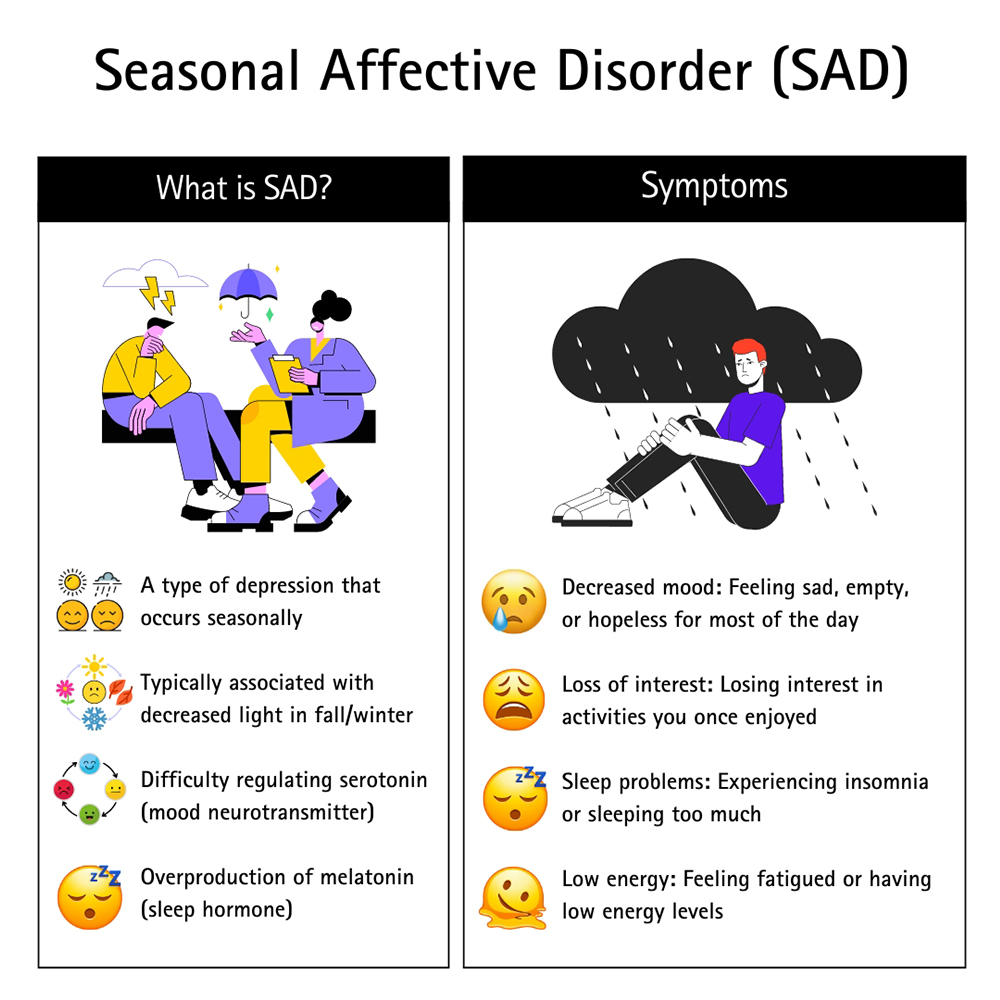What Is Seasonal Affective Disorder (SAD)?
Seasonal affective disorder (SAD) is a type of depression that occurs at a certain season. SAD is typically associated with decreased light around fall and winter time. SAD is a difficulty regulating serotonin, a neurotransmitter responsible for regulating mood. It is believed that people with SAD also have an overproduction of melatonin. Melatonin is a hormone responsible for sleep.
Symptoms of SAD are similar to those of Major Depressive Disorder (MDD), including:
- Decreased mood for most of the day for at least 2 weeks at a time
- Feelings of sadness, emptiness, and hopelessness
- Loss of interest in things you used to enjoy
- Problems with sleep (insomnia or sleeping too much)
- Low energy levels
- Appetite changes
- Difficulty concentrating
- Social withdrawal
While SAD is usually associated with occurring in the winter months, it is also possible to experience symptoms in the spring and summer.

How Common Is Seasonal Affective Disorder (Sad)?
Seasonal Affective Disorder affects about 5% of the U.S. population. SAD occurs four times more often in women than in men. SAD is linked to a biochemical imbalance due to shorter daylight hours.
Who Is at Risk for Seasonal Affective Disorder (Sad)?
Those at risk for SAD include:
- People who live in an area with less daily sunlight are more at risk for SAD. Typically, these are areas further from the equator.
- Individuals with a family history of depression, bipolar disorder, or SAD.
- Women are more at risk for SAD than men.
- Individuals ages 18 to 30 are more likely to experience symptoms of SAD.
- People with irregular circadian rhythms may be more prone to SAD
How Is Seasonal Affective Disorder (SAD) Diagnosed?
Therapists use the DMS-5 to diagnose mental disorders. The DSM-5 states that to be diagnosed with SAD an individual must experience symptoms of Major Depressive Disorder in a particular time of year. Your therapist may interview you to learn about your experience or administer a Patient Health Questionnaire (PHQ-9) to determine the severity of your depression symptoms. Therapists can also provide the Seasonal Pattern Assessment Questionnaire to diagnose SAD. This tool can be self-administered and can be found online.
Embrace Healing The Power of Trust in Therapeutic Relationships
“In my experience, the most effective aspect of therapy is the therapeutic relationship. Establishing trust between a client and clinician is the first step to healing.”
How Is Seasonal Affective Disorder (Sad) Treated?

SAD can be treated with the following interventions:
- Cognitive behavioral therapy: CBT focuses on identifying negative thinking patterns and beliefs and developing skills to challenge and reframe those. CBT aims to change your dysfunctional thinking patterns and adapt more positive beliefs to impact positive behavior change.
- Light therapy: In this form of therapy, the client sits in front of a light box that mimics daylight to regulate the production of serotonin and melatonin.
- Relaxation techniques: Your therapist can help you identify and develop healthy coping and relaxation skills to better deal with symptoms of SAD.
- Mindfulness therapy: Practicing mindfulness and presence can help manage depression symptoms and stress and improve overall mental well-being.
Other options for SAD treatment include:
- Medications such as selective serotonin reuptake inhibitors (SSRI) to help regulate mood.
- Vitamin D is thought to improve symptoms of SAD, especially in individuals with vitamin D deficiency.
- Lifestyle changes can help improve symptoms by integrating healthy coping skills, improved nutrition, healthy sleep hygiene, and physical movement.
Can I Prevent Seasonal Affective Disorder (Sad)?
While it may not be possible to completely avoid SAD, some things you can do to decrease the risk for symptoms include:
- Sunlight exposure: Spending adequate time outside in sunlight can help decrease your risk of SAD. Try going outside first thing in the morning, open the blinds, or simply sit by the window if possible.
- Nutrition: Healthy eating habits can greatly affect mental health. Try to get enough proteins, healthy fats, and fruits and vegetables daily.
- Sleep: Getting enough sleep is more important than most people think. Research shows that most adults need 7-9 hours of sleep per night.
- Physical movement: Your daily exercise does not need to be extreme. It is important to remember that any physical activity is good for your mental and overall well-being. Try to go for a walk or take a stretch whenever possible.
- Social support: As social beings, we need some level of social support in our lives to maintain satisfaction. Spend some time with friends and family, make a phone call, or attend a support group.
When Should I See My Healthcare Provider About Seasonal Affective Disorder (SAD)?
If you suspect you may be experiencing symptoms of SAD it is important to see a health care provider, such as a therapist.
If you experience any of the following symptoms, consider scheduling an appointment or consultation with one of our therapists:
- Symptoms of depression such as persistent sadness, low energy, sleep disturbance, loss of interest in activities, or feelings of emptiness
- Your symptoms last for at least 2 weeks
- You notice your symptoms occur at a specific time of year, especially during the winter or fall months
- Your symptoms are interfering with your quality of life
You don’t have to wait until symptoms become debilitating to seek help. You can always call a therapist even if you are just experiencing a stressful situation. Asking for help can be scary, but it takes strength and bravery to reach out.
Does Light Therapy Work for Depression?
Bright light therapy (BLT) has been proven to be an effective treatment for seasonal affective disorder (SAD). Over 19 studies have shown that BLT was superior to placebo treatment. BLT is a type of therapy in which a lightbox is used that emits light similar in wavelength to natural light. During this treatment, clients sit about 2 feet from the light box for 30 to 60 minutes.
The light causes the body to create neurotransmitters such as serotonin and melatonin, affecting mood and sleep. Recently, BLT has been studied for non-seasonal depression. Research showed BLT had statistically significant mild to moderate treatment effects in reducing depressive symptoms. However, it is important to note that there are currently not many studies available on BLT for non-seasonal depression.
How Does Online Therapy Work for Seasonal Depressive Disorder?
Online therapy for SAD works similarly to in-person therapy. You can expect to meet with your highly rated counselor at a regular time at an interval you decide with your provider. You can meet over a video session or phone call. Meeting online with your therapist may provide more convenience for you regarding scheduling and eliminating travel time.
What Is Involved in Seasonal Affective Disorder Therapy?
Knowing what to expect in therapy can help you feel more comfortable and at ease.
Here are some things you can look forward to in SAD therapy:
- Initial visit: The first time you meet with your therapist you can expect to discuss aspects of your past, life growing up, and any major life events.
- Follow-up session: In your follow-up, your therapist will guide you through identifying your goals and setting objectives for achieving these goals.
- Weekly/bi-weekly sessions: In your following sessions you and your therapist will work on your goals using different evidence-based interventions, develop coping skills, and identify tools to help you achieve more satisfaction in your life.
If you think you are experiencing symptoms of SAD talk to a counselor, You can begin to stabilize your emotions and enjoy both the summer and winter months.
What Are My Next Steps in Getting Help Through Seasonal Affective Disorder Therapy?
If you are interested in learning more about SAD therapy contact us at Florida Trauma Therapy Center to schedule an assessment.
Don’t let seasonal depression control your life any longer. At the Trauma Therapy Center, we offer the best treatment for seasonal depression, empowering you to break free from its grasp. Take the first step towards a brighter future by scheduling a free consultation with us today and embarking on a journey of healing and transformation.

